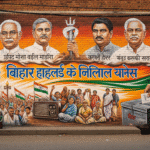Exploring the Complex Relationship Between Advertising Revenue and Editorial Independence
Key Metrics:
- Advertising Spend: India’s advertising industry is projected to reach over $10 billion by 2024, with digital advertising growing at 14% annually.
- Media Revenue Models: Advertising contributes to approximately 70% of the revenue for major Indian news outlets.
- Impact on Content: Studies in 2023 indicate that 60% of Indian journalists have felt pressure to modify stories due to advertiser preferences.
In India’s rapidly evolving media landscape, the financial interdependence between news outlets and advertisers has raised pressing questions about the integrity of journalism and the autonomy of editorial content. As advertising dollars become a significant source of revenue for media houses, the line between advertising and editorial content often blurs, leading to potential conflicts of interest that can sway how news is reported.
The Influence of Advertising on News Content
The reliance on advertising revenue is particularly evident in the struggle for high circulation and viewership numbers, which directly impact advertising rates. In an effort to attract lucrative advertising contracts, some media outlets may prioritize content that aligns with the interests of their major advertisers. This can result in a phenomenon known as “advertorials,” where advertising content is disguised as objective news, potentially misleading viewers and diminishing journalistic credibility.
For instance, during major sales events like Diwali, coverage of e-commerce platforms significantly increases. Media reports often disproportionately highlight the positive aspects of shopping with these platforms, while downplaying or ignoring consumer complaints or broader economic impacts such as effects on small retailers.
Case Studies and Examples
Recent investigations have revealed instances where media outlets delayed or altered investigative reports that could negatively affect their advertisers. A notable case involved a leading newspaper that postponed a story on automobile defects from a major car manufacturer, a significant advertiser, until after the festive season to avoid affecting car sales.
Digital media, with its highly targeted advertising capabilities, faces similar challenges. Platforms like YouTube and Facebook offer advertisers tools to place their ads next to specific content, influencing what digital media channels are more likely to cover.
Regulatory Framework and Ethical Guidelines
In response to these concerns, bodies like the Advertising Standards Council of India (ASCI) have put forth guidelines aiming to ensure that advertisements are clearly distinguished from editorial content. However, enforcement remains inconsistent, and many news consumers remain unaware of the extent to which content might be influenced by commercial interests.
Media watchdogs and industry experts have been calling for more stringent regulations that mandate transparency in content sponsorship and advertising. Additionally, there is a growing push for media literacy initiatives to help the public better understand and critically evaluate the content they consume.
Journalistic Integrity and the Path Forward
To preserve journalistic integrity, some media houses are experimenting with alternative revenue models, such as subscriptions and membership programs, which reduce dependency on advertising dollars. These models not only provide more stable revenue streams but also align the outlet’s financial incentives with the interests of its readers rather than its advertisers.
Conclusion
The complex relationship between advertisers and media houses in India underscores a critical challenge for journalism: maintaining editorial independence while financially viable. As the media landscape continues to evolve, the industry must balance commercial realities with ethical standards to ensure that the news remains a trustworthy source of information for the public. The economy of news is not just about profitability but about protecting the fundamental principles of truthful and unbiased reporting in the face of commercial pressures.








